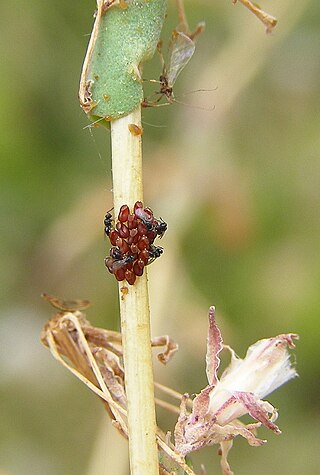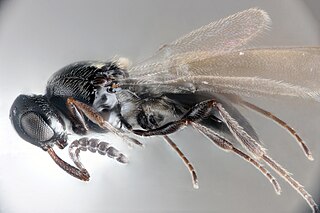
The hymenopteran family Platygastridae is a moderate-sized group of exclusively parasitoid wasps, mostly very small (1–2 mm), black, and shining, with geniculate (elbowed) antennae that have an eight-segmented flagellum. The wings sometimes lack venation, though they may have slight fringes of setae.

Platygaster is a genus of parasitoid wasps in the family Platygastridae. There are more than 560 described species in Platygaster.
Calliscelio is a parasitoid wasp genus which contains two species, C. elegans and C. teleogrylli.
Anteris is a genus of wasps in the family Platygastridae. There are about 15 described species in Anteris.

Telenomus fariai is a parasitoid wasp in the family Platygastridae that parasitizes various bugs in the genus Triatoma. It was described by Irish entomologist Alexander Henry Haliday in 1833.

Synopeas is a genus of parasitoid wasps in the family Platygastridae. There are about 400 described species in Synopeas.
Oethecoctonus is a genus of parasitoid wasps in the family Platygastridae. There are about six described species in Oethecoctonus.
Metaclisis is a genus of parasitoid wasps in the family Platygastridae. There are at least 30 described species in Metaclisis.

Macroteleia is a genus of parasitoid wasps in the family Platygastridae. There are more than 140 described species in Macroteleia.

Trichacis is a genus of parasitoid wasps in the family Platygastridae. Members of this genus have a tuft of setae on the mesoscutellum and transverse striae or rugulae above the antennae. They are parasitoids of Cecidomyiidae, although the hosts of most species remain unknown.
Paul Irwin Forster is an Australian botanist. He obtained his doctorate from the University of Queensland in 2004 with his thesis The pursuit of plants : studies on the systematics, ecology and chemistry of the vascular flora of Australia and related regions.
Amblyaspis is a genus of parasitoid wasps belonging to the family Platygastridae.
Anopedias is a genus of parasitoid wasps belonging to the family Platygastridae.
Isostasius is a genus of parasitoid wasps belonging to the family Platygastridae.
Piestopleura is a genus of insects belonging to the family Platygastridae.
Isocybus is a genus of parasitoid wasps belonging to the family Platygastridae.
Allotropa is a genus of parasitoid wasp in the family Platygastridae. The genus has an almost cosmopolitan distribution.
Paridris is a genus of wasps belonging to the family Platygastridae.
Sparasion is a genus of wasps belonging to the family Sparasionidae, within the superfamily Platygastridae. The genus has specimens widespread in Eurasia, Africa, and temperate North America.




